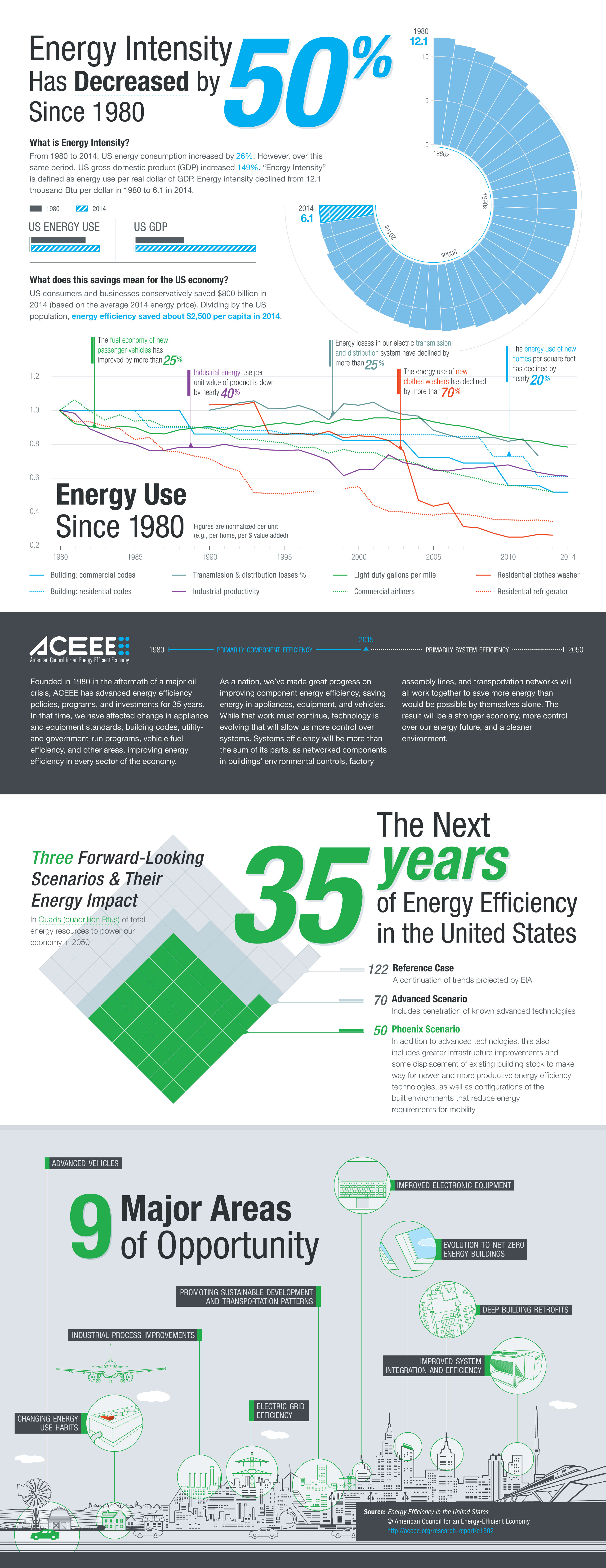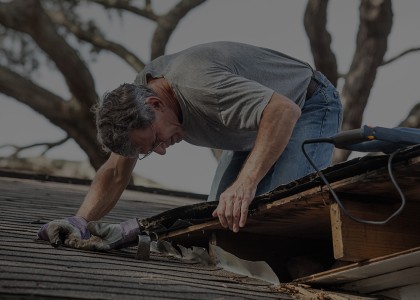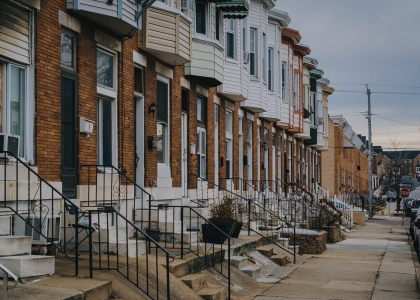Huge Advances in Energy Efficiency Spurred Economic Growth, Jobs, Lowered Bills; Consumers and Businesses Saved About $800 Billion Due to Energy Efficiency Last Year.
Washington, D.C. – Energy efficiency has made major strides in the US in the last 35 years, with “energy intensity” – the measurement of energy used per dollar of gross domestic product – down from 12.1 thousand Btus per dollar in 1980 to 6.1 thousand Btus per dollar in 2014, according to a major new report from the nonprofit American Council for an Energy-Efficient Economy (ACEEE).
ACEEE found that about 60 percent of the improvement in energy intensity over the report’s 35-year period was due to energy efficiency and about 40 percent to major structural changes in the economy. The bottom line: Just the energy efficiency portion saved US consumers and businesses about $800 billion in 2014, roughly $2,500 per capita. Even though U.S. energy use edged up by 26 percent from 1980 to 2014, the U.S. gross domestic product (GDP) increased by 149 percent.
The ACEEE report is available online at http://aceee.org/research-report/e1502.
Issued to mark ACEEE’s 35th anniversary, “Energy Efficiency in the U.S.: 35 Years and Counting” also looks ahead and concludes that “(w)hile much progress has been made, there are large and cost-effective energy efficiency opportunities that, by 2050, can collectively reduce energy use by 40–60 percent relative to current forecasts.”
Examples of energy-efficiency advances since 1980 cited in the report include the following:
- The energy use of new clothes washers has declined by more than 70 percent.
- The energy use of new homes per square foot has declined by nearly 20 percent.
- Industrial energy use per unit value of product is down by nearly 40 percent.
- The fuel economy of passenger vehicles has improved by more than 25 percent.
- Energy losses in the US electric transmission and distribution system have declined by more than 25 percent.
Report co-author and ACEEE Executive Director Steven Nadel said: “Energy efficiency has made great strides in the past 35 years, and we have learned many important lessons on how markets and policies can work together to advance it. Looking forward, we find opportunities to reduce 2050 energy use by half relative to a business-as-usual reference case. In order to harvest these large efficiency opportunities, we need to take our efforts to a higher level. The challenges are many, but so are the benefits in terms of lower energy bills, a stronger economy, improved energy security, and a cleaner environment. The past has shown us what efficiency can do and it can guide us to even greater success in the future.”
The ACEEE report notes: “Efficiency investments and savings also generate jobs, including direct jobs installing efficiency measures, indirect jobs upstream in the supply chain, and jobs induced as energy bill savings are spent elsewhere and multiply through the economy. Energy savings can also help to drive modest overall growth in the US economy … Further, energy efficiency savings over the past 35 years have contributed to our nation’s security and improved our environment … Reductions in energy consumption also mean reduced emissions of fuel-combustion by-products, including sulfur dioxide and nitrogen oxides (contributors to acid rain and smog), mercury and other toxic metals (contributors to health problems), and carbon dioxide (the predominant greenhouse gas).”
To achieve even deeper energy efficiency advances in the next 35 years, the ACEEE report recommends:
- Better systems integration, including through “intelligent efficiency,” i.e., the use of sensors, controls, big data, and computer chips to monitor and control energy use in real time.
- Improvements to the many types of equipment (such as computers, televisions, and elevators) that collectively account for growing miscellaneous energy loads.
- Evolution of building design to yield zero net energy and ultra-low-energy buildings.
- Industrial process improvements.
- Increased use of advanced vehicles, including electric, hybrid, and self-driving vehicles.
- Taking building energy retrofits to a much higher level, including more widespread and deeper retrofits for larger savings per building.
- Better efficiency of the electric grid through expanded use of combined heat and power systems, greater power plant efficiency, reduced transmission and distribution losses, expanded use of other distributed generation resources, and improved grid control and integration.
- Promotion of sustainable development and transportation patterns.
- Initiatives to change wasteful energy-using behaviors among consumers and businesses.
The American Council for an Energy-Efficient Economy acts as a catalyst to advance energy efficiency policies, programs, technologies, investments, and behaviors.




